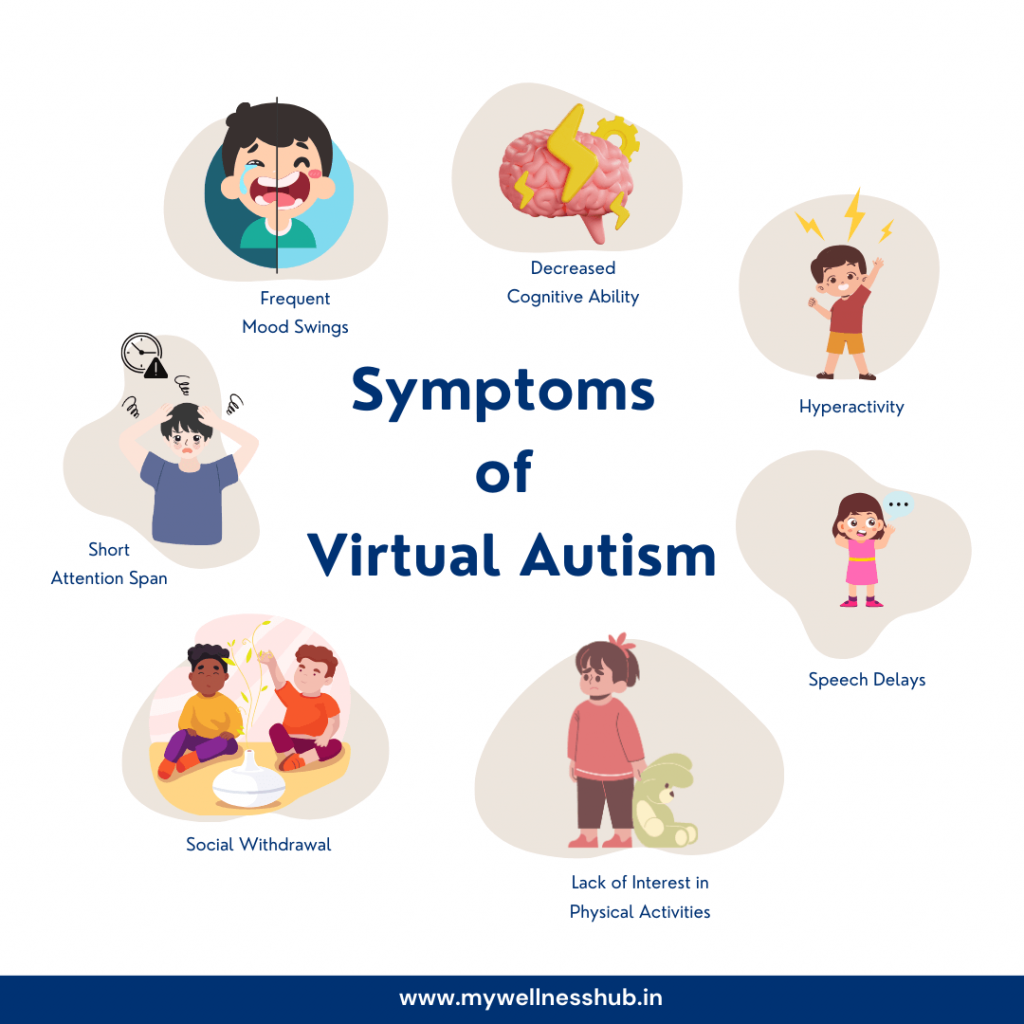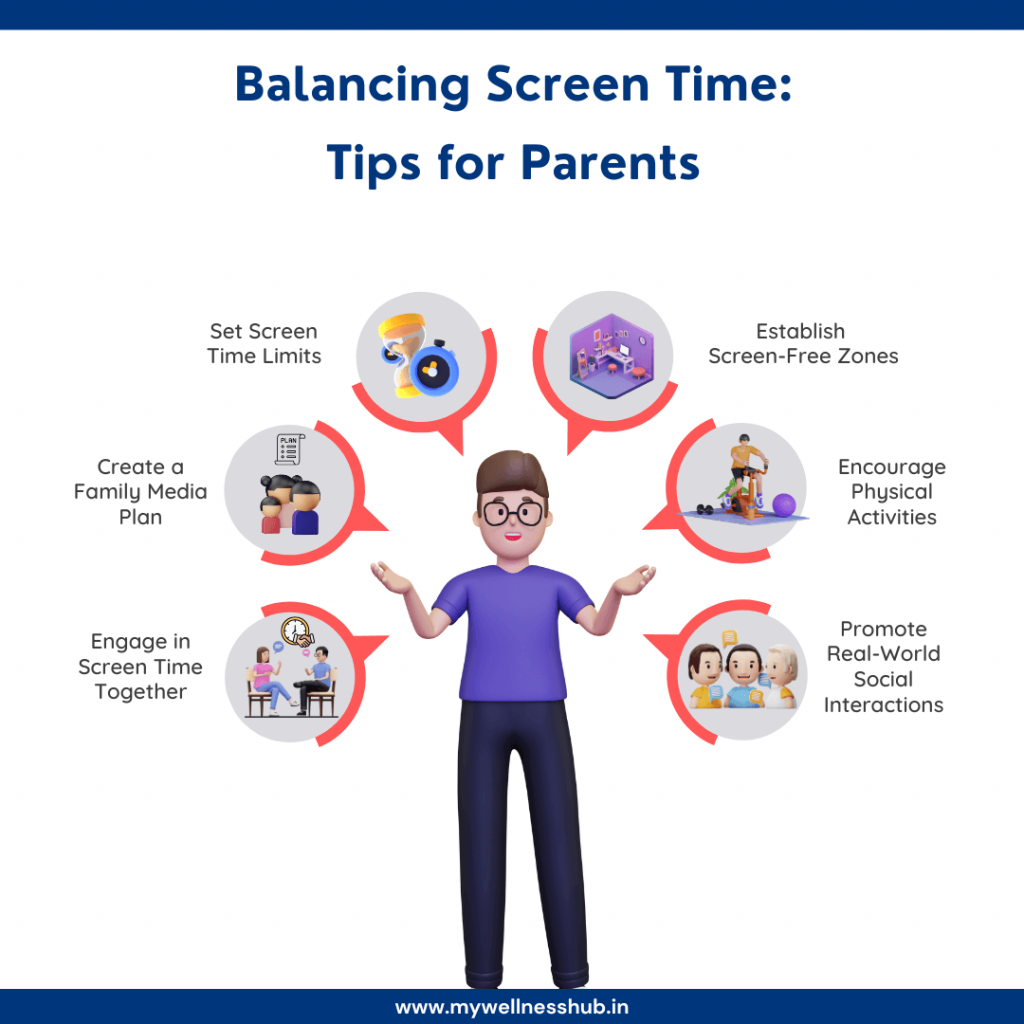Symptoms of Virtual Autism in The Digital Age
By Rajini D
Last Updated: April 29, 2024
In a world where digital devices are as common in homes as furniture, a new concern is emerging among parents and educators alike: virtual autism. This term may sound futuristic, but it’s becoming increasingly relevant as we navigate our technology-infused lives. Virtual autism is not about robots or virtual reality games; it’s about the very real impact excessive screen time can have on our youngest generation’s development.
Understanding the symptoms of virtual autism early on is crucial for effective management and support. Just like a plant needs the right balance of sunlight, water, and nutrients to thrive, children need a balanced environment that includes not just screens for learning and entertainment but also ample opportunities for physical play, social interaction, and creative exploration. Recognizing the signs of virtual autism is the first step in ensuring that our children grow into healthy, well-adjusted adults.
What Is Virtual Autism?
Virtual autism arises not from genetic predispositions but from environmental influences, specifically the high volume of screen time children are exposed to from a tender age. It’s a response to the digital age’s demands, where tablets and smartphones become the primary modes of entertainment and even companionship for the little ones. The condition spotlights the sensory, motor, and socio-affective scarcities observed in children who, instead of exploring the world through physical interaction and play, spend significant time in front of screens.
Also read: Oral motor Exercises: Key to Better Speech
Recognizing the Symptoms

As we peel back the layers of virtual autism, understanding the symptoms is our next step. Identifying these signs early can be pivotal in taking proactive measures to balance our children’s digital and physical world interactions. Here’s a conversational look at some common symptoms associated with virtual autism:
- Reduced Attention Span: Have you ever noticed how quickly a child loses interest in tasks that do not involve a screen? This shortened attention span is a hallmark of virtual autism. It’s the result of constant digital stimulation, where the brain craves the rapid pace of online content, making everyday activities seem dull in comparison.
- Speech Delay: In the critical years of language development, face-to-face interaction plays a crucial role. Kids with high screen time may miss out on this interactive play, leading to delays in speech and language milestones. The back-and-forth of conversation is hard to replicate with a device.
- Hyperactivity: The intense sensory input from screens can overwhelm a child’s nervous system, manifesting as restless or impulsive behavior. Without the natural outlet of physical play, this hyperactivity can increase, affecting the child’s ability to focus or stay still.
- Difficulty with Emotional Regulation: Excessive screen time can impact a child’s developing ability to manage emotions. Frustration, anger, or sadness might seem harder for them to navigate, leading to emotional dysregulation.
- Impaired Social Skills: Social cues like facial expressions, body language, and the nuances of conversation are learned through in-person interactions. Children immersed in the digital world may find these social intricacies challenging, affecting their ability to forge strong interpersonal connections.
Recognizing these symptoms isn’t about pinpointing blame or instilling fear; it’s about awareness and action. By understanding the signs of virtual autism, we can take steps to ensure our children’s digital experiences are enriching, not restrictive.
Causes Behind the Screen
Peering behind the digital curtain, we uncover the core causes of virtual autism, each playing a crucial role in shaping our children’s developmental journey. These aren’t just technical glitches; they’re lifestyle imbalances that demand our attention. Let’s navigate through the main culprits:
Excessive Screen Time
The digital world is mesmerizing, offering endless entertainment and information at our fingertips. However, when screen time eclipses all other activities, it can derail a child’s developmental track. The brain, especially in the formative years, thrives on a variety of stimuli—colors, textures, sounds, and movements that screens can’t fully replicate. Excessive screen engagement limits these real-world sensory experiences, potentially leading to virtual autism symptoms.
Limited Physical Activity
Remember the days of outdoor adventures, where every tree was a mountain and every backyard a kingdom? Today, digital devices often anchor children indoors, reducing opportunities for physical play. This shift not only impacts physical health but also affects emotional and social development. Physical activity is not just about staying fit; it’s about exploring, learning, and interacting with the environment—essential components missing from a sedentary, screen-focused lifestyle.
Unbalanced Lifestyle
A balanced lifestyle for a child includes learning, playing, socializing, and resting. Nowadays, the scales are tipping, with digital engagement outweighing other crucial activities. This imbalance can stifle creativity, problem-solving skills, and the ability to engage deeply in tasks. Cultivating a harmonious blend of activities is vital, ensuring children grow into well-rounded individuals capable of navigating both digital and physical realms.
Lack of Face-to-Face Interaction
In the dance of social interaction, non-verbal cues, tone variations, and emotional exchanges lead. Screens, while offering a semblance of connection, fall short of providing the full spectrum of human interaction. Direct, face-to-face communication fosters empathy, understanding, and emotional intelligence—skills crucial for personal and professional success. By sidelining these interactions, we risk developing a generation more fluent in emojis than in emotional connections.
Also read: Virtual Autism vs. Autism: What Parents Need to Know
Prevention and Management Strategies

Navigating the digital landscape as a parent can feel like charting unexplored territory. With the goal of fostering a balanced lifestyle for our children, here are some practical strategies to prevent and manage symptoms of virtual autism, ensuring that screen time enhances rather than hinders their development.
Establish Clear Screen Time Guidelines
Creating a family media plan that outlines when, where, and how screens can be used is crucial. This might include tech-free zones in the home, such as bedrooms and dining areas, and tech-free times, like during meals and an hour before bedtime. Remember, consistency is key to making these guidelines effective.
Promote Physical Activities
Encourage your child to engage in physical play, sports, and outdoor activities. These not only offer a healthy outlet for their energy but also provide essential sensory experiences that screens cannot replicate. From a game of tag to family hikes, physical activities are invaluable for development and well-being.
Foster Real-World Social Interactions
Arrange playdates, family gatherings, and community activities that encourage face-to-face interactions. Participating in group activities, such as team sports, music classes, or art clubs, can also enhance social skills and reduce reliance on digital devices for entertainment.
Cultivate a Culture of Reading and Creative Play
Introduce a variety of books, craft materials, puzzles, and board games to spark creativity and imagination. These activities not only offer a break from screens but also promote cognitive development and family bonding.
Model Healthy Digital Habits
Children learn by example, so it’s important for parents and caregivers to also adhere to the screen time guidelines set for the family. Show your child that there’s a time for digital activities and a time for offline interests and interactions.
Utilize Technology Wisely
Not all screen time is created equal. Choose high-quality, educational content that encourages active rather than passive engagement. Setting limits on entertainment screen time while promoting educational and creative uses can help strike a balance.
Activities to Replace Screen Time
| Age Group | Indoor Activities | Outdoor Activities |
|---|---|---|
| Under 2 years | – Cuddling, reading aloud – Sensory bins – Singing, dancing | – Playing in the sandbox – Water play – Short walks in the stroller |
| 2-4 years | – Storytime, picture books – Simple puzzles – Non-toxic crafting (like play dough) | – Playground visits – Backyard scavenger hunts – Splashing in puddles |
| 5-12 years | – Reading books, comics – Building models (LEGO, clay) – DIY projects, science kits | – Riding bicycles, scooters – Team sports (soccer, basketball) – Gardening, nature projects |
| Teens | – Reading novels, graphic novels – Board games, card games – Cooking, baking together | – Hiking, camping – Competitive sports – Community service, volunteering |
Know more about on our article History of Autism: Unraveling Autism’s History
Seeking Professional Help
Wellness Hub’s Holistic Approach
At Wellness Hub, we believe in a holistic approach to child wellness, acknowledging that each child is unique and that their well-being is influenced by a variety of factors, including their digital environment. Our approach aligns with managing symptoms of virtual autism by:
- Offering guidance on creating a balanced digital lifestyle for children.
- Providing resources that promote physical activity, social interaction, and creative play as counterbalances to screen time.
- Connecting families with professional services, including counseling and therapy, to address specific challenges.
- Organizing workshops and seminars for parents and educators on navigating the digital age with children’s health in mind.
Seeking professional help is a step towards empowerment—not just for your child, but for your entire family. It’s about equipping yourselves with the tools and knowledge to create an environment where your child can thrive, both offline and online.
Screen Time Recommendations by Age
| Age Group | Recommended Screen Time |
|---|---|
| Under 2 years | None. Focus on interactive, unstructured play and face-to-face time to support cognitive and social development. |
| 2-4 years | Up to 1 hour/day. Choose high-quality, educational content and watch together to help understand and apply what they see. |
| 5-12 years | Balanced with physical activity. Screen time should not replace physical, social, and educational activities. |
| Teens | Limited and purposeful. Encourage teens to be mindful of their digital consumption and engage in diverse activities. |
Read more: Unlocking Communication: Effective Speech Therapy for Autism
Conclusion
In wrapping up our discussion, it’s clear that understanding virtual autism and managing screen time wisely is essential for helping our children thrive in both the digital and real worlds. It’s all about staying informed about the potential impacts of too much screen time and being proactive in creating a balanced lifestyle for our kids. This balance includes not just technology but also physical activities, face-to-face interactions, and creative pursuits. By setting boundaries and engaging with our children’s digital experiences, we can guide them toward healthy habits and open up opportunities for learning and bonding.
Remember, you’re not alone in navigating the complexities of the digital age. At Wellness Hub, we’re here to offer support, resources, and guidance to ensure your family finds a healthy balance between screen time and real-world experiences. Embracing technology with mindfulness and intention can empower our children to make the most of its benefits while growing into well-rounded individuals. Let’s work together to make this journey a positive and enriching one for our children.
Frequently Asked Questions:
1. What exactly does “virtual autism” mean?
Virtual autism refers to a set of behaviors and symptoms that mimic those of Autism Spectrum Disorder (ASD), triggered by excessive screen time and digital device use among young children. It emphasizes the impact of digital environments on child development, particularly concerning social skills, attention span, and emotional regulation.
2. How can I recognize symptoms of virtual autism in my child?
Symptoms of virtual autism include reduced attention span, speech delays, hyperactivity, difficulty with emotional regulation, and impaired social skills. Observing your child’s behavior, both with and without digital devices, can help identify these symptoms.
3. What causes virtual autism?
Key factors contributing to virtual autism include excessive screen time, limited physical activity, an unbalanced lifestyle, and a lack of face-to-face interaction. These elements disrupt typical development patterns, leading to symptoms associated with virtual autism.
4. Can virtual autism be prevented?
While virtual autism isn’t a medical diagnosis, its symptoms can be managed or mitigated through balanced screen time, encouraging physical activities, fostering real-world interactions, and ensuring a varied and enriching environment for children.
5. What are some effective strategies for managing my child’s screen time?
Effective strategies include establishing clear screen time rules, promoting physical play and activities, engaging in family time without screens, and encouraging hobbies and interests that do not involve digital devices.
6. When should I seek professional help for virtual autism symptoms?
If you notice persistent symptoms of virtual autism that significantly affect your child’s daily functioning or development, consulting with a pediatrician or a child development specialist can provide guidance and appropriate intervention strategies.
7. How can Wellness Hub help with managing virtual autism symptoms?
Wellness Hub offers a holistic approach to child wellness, providing resources, guidance, and support for families navigating the digital age. From tips on balancing screen time to connecting with professional services, Wellness Hub is committed to supporting your child’s healthy development in a digital world.
8. How does the digital age affect a child’s development?
The digital age offers unprecedented access to information and learning opportunities but also poses challenges for child development. Excessive screen time can impact social skills, physical activity levels, and attention spans. Balancing digital interactions with real-world experiences is crucial for healthy development.
9. What are the recommended screen time limits for children?
Screen time recommendations vary by age. The World Health Organization suggests no screen time for children under 2, and a maximum of one hour per day for children aged 2-4. For older children and adolescents, it’s essential to ensure screen time doesn’t interfere with adequate physical activity, sleep, and other healthy behaviors.
10. Can technology in education contribute to virtual autism symptoms?
While technology can be a powerful tool for learning, its role in education must be carefully managed to prevent overreliance and ensure it complements traditional teaching methods. A balanced approach, integrating both digital and hands-on learning experiences, can mitigate the risk of symptoms associated with virtual autism.
About the Author:
Rajini Darugupally
M.Sc., Speech-Language Pathologist (9+ years of experience)
Rajini is a passionate and dedicated Speech-Language Pathologist with over 9+ years of experience, specializing in both developmental speech and language disorders in children and rehabilitation in adults. Driven by a desire to empower each individual to find their voice, Rajini brings a wealth of experience and a warm, genuine approach to therapy.
Currently, at Wellness Hub, she thrives in a team environment that values innovation, compassion, and achieving results for their clients.
Connect with Rajini to learn more about how she can help you or your loved one find their voice.
Book your Free Consultation Today
Parent/Caregiver Info:
Client’s Details:
* Error Message









